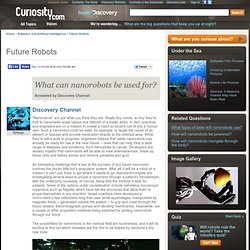

What can nanorobots be used for? - Curiosity. "Nanorobots" are just what you think they are: Really tiny robots, so tiny they're built to nanometer-scale (about one billionth of a meter wide).

In fact, scientists and engineers are on a mission to create a robot so small it can fit into a human vein. Such a nanorobot could be used, for example, to target the cause of an ailment or disease and provide medication directly to the infected area. While they're still a work in progress, engineers believe that viable nanorobots may actually be ready for use in the near future -- ones that can help treat a wide range of diseases and conditions, from hemophilia to cancer. Developers are already hopeful that nanorobots will be able to treat arteriosclerosis, break up blood clots and kidney stones and remove parasites and gout.
Nouvel espoir dans la lutte contre le cancer : un nanorobot à base de bactéries est capable de soigner la maladie. La robotique ne cesse de fasciner et d’impressionner au fil de ses innovations.

C’est une nouvelle fois le cas avec ces nanorobots révolutionnaires conçus à base de bactéries qui sont mis au service de votre santé. DGS vous présente ces machines composées de microbes qui permettront de guérir le cancer. C’est une nouvelle fois du continent asiatique que nous vient cette innovation robotique qui devrait représenter une avancée scientifique et technologique parmi les plus notables des années à venir. Ainsi, si les chinois avaient réussi à introduire un nanorobot à l’intérieur d’un organisme humain au cours du mois de septembre 2013, c’est en Corée du Sud que ces robots-bactéries capables de traiter le cancer ont vu le jour, dans l’Université Nationale de Chonnam. European Researchers Win $1.3 Billion To Simulate The Human Brain. Henry Markram, whose simulated rat brain we have covered before, now wants to build a human brain simulator one neuron at a time.

That might take a little while, since there are roughly 86 billion neurons crammed in the average person's skull. But then again, Markram just scored funds--one and a half cents for each neuron. Markram is head of the Switzerland-based Human Brain Project, which won $1.3 billion last month to build the human brain in a silicon substrate. Awarded by the European Commission, the prize will be doled out over the next decade as the researchers model brain cells down to the thousands of synapses on each neuron that pass signals between the cells. The Human Brain Project is a collaboration between some 80 research institutions in Europe.
Markram's "Blue Brain" rat brain project is Mickey Mouse business compared to the new project, because Blue Brain models just roughly one million neurons. What is the Blue Brain project? - Curiosity. The Blue Brain Project is an initiative started by the EFPL (École Polytechnic Fédérale de Lausanne) in 2005.

The goal behind the project is to use a computer to model the human brain. Ideally, the result would be a virtual brain that would behave just as an organic brain would. With this virtual model at the ready, scientists could experiment with treatments and procedures without endangering an actual human being. It could be a boon to neuroscience research. Of course, making an artificial brain is an enormous computational and theoretical challenge. Top Ten Transhumanist Technologies. By Lifeboat Foundation Scientific Advisory Board member Michael Anissimov.

Overview Transhumanists advocate the improvement of human capacities through advanced technology. Not just technology as in gadgets you get from Best Buy, but technology in the grander sense of strategies for eliminating disease, providing cheap but high-quality products to the world’s poorest, improving quality of life and social interconnectedness, and so on. Technology we don’t notice because it’s blended in with the fabric of the world, but would immediately take note of its absence if it became unavailable. (Ever tried to travel to another country on foot?) The List 10. Cryonics is the high-fidelity preservation of the human body, and particularly the brain, after what we would call death, in anticipation of possible future revival. 9.
The above image may look like a photo, but it’s actually a screenshot from the game Crysis, a first-person shooter which will be released later this year. 8. 7. Prosthetic Limb Control " Different types of prosthetic limbs are designed with different goals in mind.

Often these goals depend on the site of the amputation and the needs of the patient. For example, a cosmetic prosthetic limb, called a cosmesis, is designed with appearance in mind rather than controllability. Advanced plastics and pigments uniquely matched to the patient's own skin tone allow a modern day cosmesis to take on an amazingly life-like appearance. Even details such as freckles, hair and fingerprints can be included, bringing the cosmesis to the point where it's nearly indistinguishable from the original missing arm or leg.
Other prosthetic limbs are designed with usability and function as a central purpose. Body-powered prosthetic limbs are controlled by cables connecting them to elsewhere on the body. Externally powered prosthetic limbs are powered with motors and can be controlled by the patient in several ways. The world's most advanced Prosthetic Hand - bebionic.